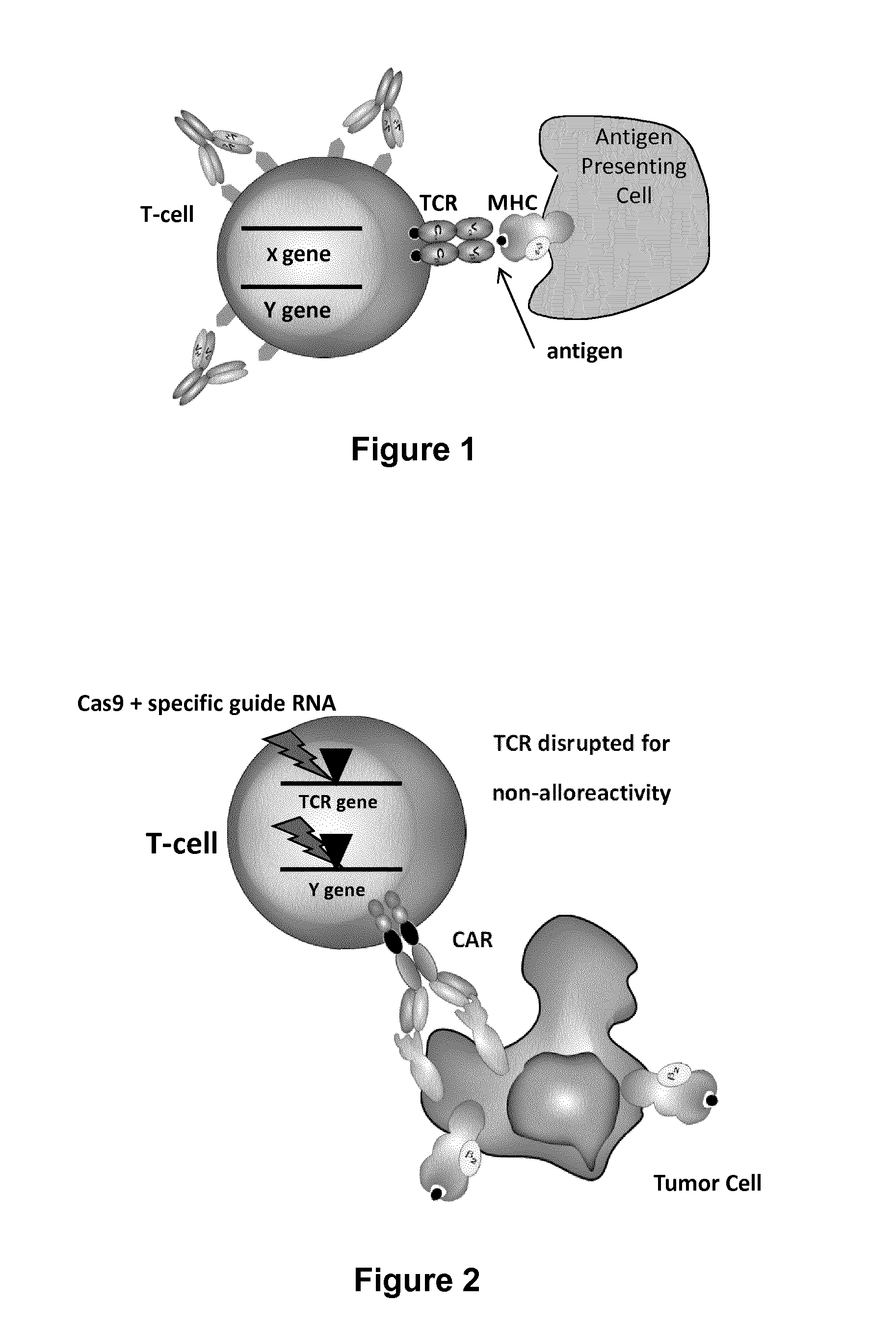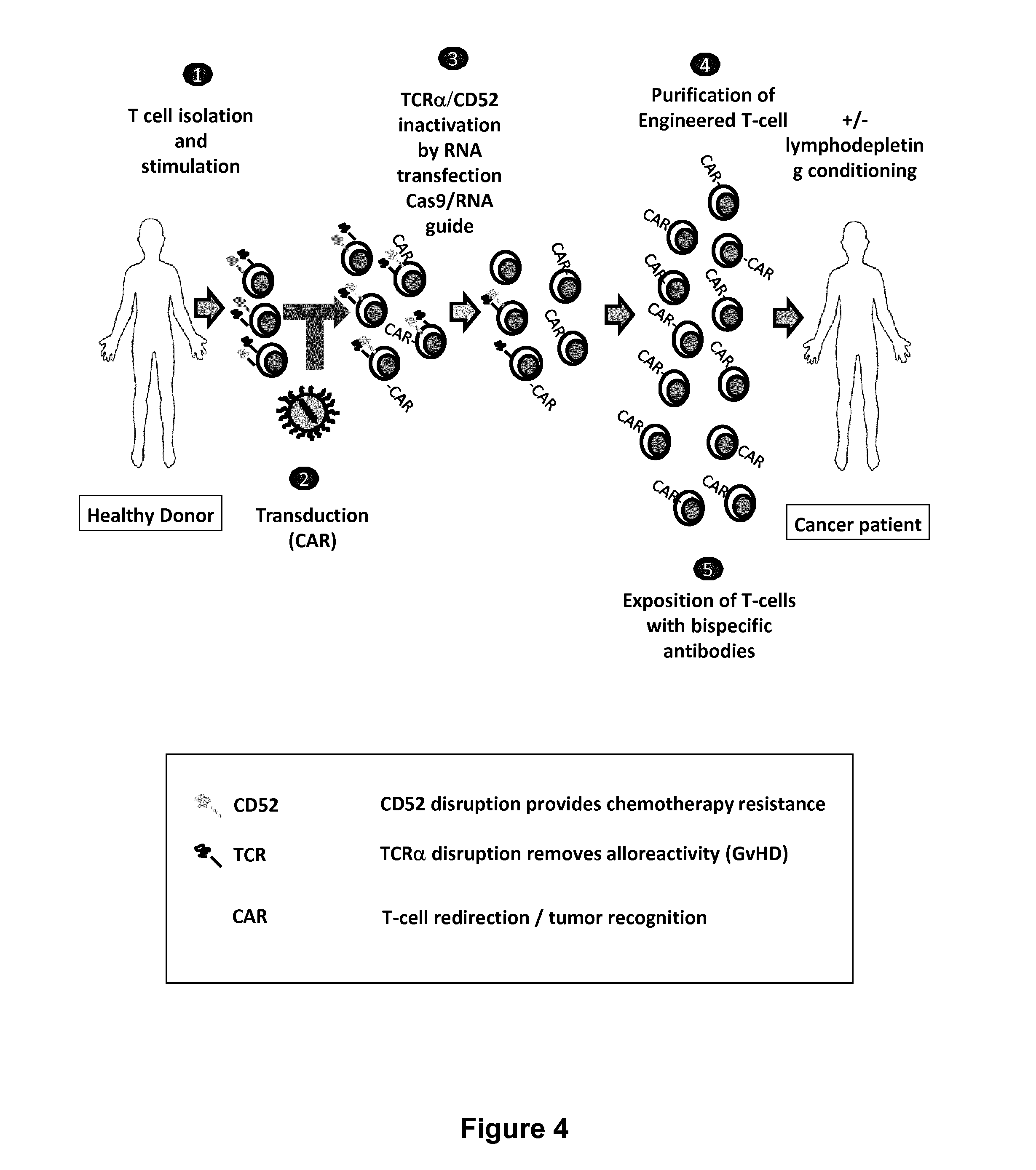Methods for engineering t cells for immunotherapy by using rna-guided cas nuclease system
a technology of cas nuclease and engineering t cells, which is applied in the direction of genetically modified cells, drug compositions, biochemical apparatus and processes, etc., can solve the problems of inability to provide prolonged expansion and anti-tumor activity in vivo, degraded immune function, and low number of patient lymphocytes
- Summary
- Abstract
- Description
- Claims
- Application Information
AI Technical Summary
Benefits of technology
Problems solved by technology
Method used
Image
Examples
example 1
General Method to Engineer Human Allogeneic Cells for Immunotherapy
[0234]For a better understanding of the invention, method to engineer human allogenic cells for immunotherapy is illustrated in FIG. 4. The method comprising a combination of one or several of the following steps:[0235]1. Providing T-cells from a cell culture or from a blood sample from one individual patient or from blood bank and activating said T cells using anti-CD3 / C28 activator beads. The beads provide both the primary and co-stimulatory signals that are required for activation and expansion of T cells.[0236]2. Transducing said cells with multi-chain CARs allow redirecting T cells against antigens expressed at the surface of target cells from various malignancies including lymphomas and solid tumors, in particular against the antigen CD19. To improve the function of co-stimulatory domain, the inventors have designed a multi-chain CAR derived from FcεRI as previously described. Transduction can be realized befor...
example 2
Specific Inactivation of TCR and CD52 Genes in the T-Cells
[0243]1—CAS9 and gRNA Plasmids Construction
[0244]The sequence encoding the Cas9 from S. pyogenes was synthesized de novo (GeneCust) and flanked by 3×NLS and a HA tag at the C-terminus (pCLS22972 (SEQ ID NO. 53)). Sequences encoding the gRNA targeting the respective 20 bp sequences (5′ to 3′) in the TCRα gene (SEQ ID NO.54) and the CD52 gene (SEQ ID NO. 55) were cloned in pUC57 derived plasmid downstream an U6 promoter leading to respectively pCLS24029 (SEQ ID NO. 56) and pCLS24027 (SEQ ID NO. 57) plasmid vectors.
2—CAS9 mRNA synthesis
[0245]mRNA encoding CAS9 was produced and polyadenylated using the mMessage mMachine T7 Ultra kit (Life technologies) following the manufacturer's instructions. The RNA was subsequently purified with RNeasy columns (Qiagen), eluted in electroporation buffer, and quantified (Nanodrop ND-1000 spectrophotometer) by measuring absorbance at 260 nm. Quality of the RNA was verified on a denaturing formal...
example 3
Functional Analysis of the Engineered T-Cells Electroporated with a Monocistronic mRNA Encoding for an Anti-CD19 Single Chain Chimeric Antigen Receptor (CAR)
[0247]To verify that genome engineering did not affect the ability of the engineered T-cells to present anti-tumor activity when provided with a chimeric antigen receptor (CAR CD19), The T-cells previously targeted using Cas9 and the specific guide RNA targeting TCRα, were further transfected with 10 μg of RNA encoding an anti-CD19 CAR. 24 hours later, T cells were incubated for 4 hours with CD19 expressing Daudi cells. The cell surface upregulation of CD107a, a marker of cytotoxic granule release by T lymphocytes (called degranulation) was measured by flow cytometry analysis (Betts, Brenchley et al. 2003).
[0248]5×106 T cells preactivated several days (3-5) with anti-CD3 / CD28 coated beads and IL2 were resuspended in cytoporation buffer T, and electroporated in 0.4 cm cuvettes without mRNA or with 10 μg of mRNA encoding a single ...
PUM
| Property | Measurement | Unit |
|---|---|---|
| voltage | aaaaa | aaaaa |
| voltage | aaaaa | aaaaa |
| voltage | aaaaa | aaaaa |
Abstract
Description
Claims
Application Information
 Login to View More
Login to View More - R&D
- Intellectual Property
- Life Sciences
- Materials
- Tech Scout
- Unparalleled Data Quality
- Higher Quality Content
- 60% Fewer Hallucinations
Browse by: Latest US Patents, China's latest patents, Technical Efficacy Thesaurus, Application Domain, Technology Topic, Popular Technical Reports.
© 2025 PatSnap. All rights reserved.Legal|Privacy policy|Modern Slavery Act Transparency Statement|Sitemap|About US| Contact US: help@patsnap.com



